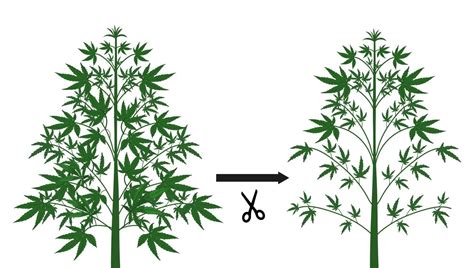How To Defoliate Cannabis
Ronan Farrow
Mar 31, 2025 · 3 min read

Table of Contents
How to Defoliate Cannabis: A Comprehensive Guide for Higher Yields
Defoliation, the process of removing cannabis leaves, is a controversial topic among growers. While some swear by its ability to boost yields and improve bud quality, others argue it can be detrimental to the plant's health. This comprehensive guide explores the whys, whens, and hows of defoliation, helping you make an informed decision for your cannabis plants.
Why Defoliate Cannabis?
The primary goal of defoliation is to improve light penetration to the lower buds. By removing excess leaves, especially large fan leaves that shade the lower parts of the plant, you allow more light to reach those buds, promoting their growth and development. This can lead to:
- Increased Yields: More light equals more photosynthesis, resulting in larger and denser buds.
- Improved Air Circulation: Removing leaves improves airflow around the buds, reducing the risk of mold and mildew.
- Better Bud Density: Light penetration leads to denser, heavier buds.
When to Defoliate Cannabis
Timing is crucial. Defoliating too early can stress the plant, hindering its growth. Defoliating too late can increase the risk of infection. The best time to defoliate is during the vegetative stage, and even then, it should be done judiciously. Here's a breakdown:
- Early Vegetative Stage (Avoid): The plant is still young and establishing its root system. Defoliation at this stage can severely weaken it.
- Mid to Late Vegetative Stage (Ideal): Once the plant has several nodes and a robust root system, it can better tolerate defoliation.
- Flowering Stage (Limited): Some growers perform light defoliation during the flowering stage to improve air circulation, but it's generally less beneficial and riskier at this point.
How to Defoliate Cannabis: A Step-by-Step Guide
Proper technique minimizes stress on your plants. Follow these steps:
1. Assess Your Plant
Carefully examine your plant to identify areas where leaves are shading lower buds. Focus on the largest fan leaves that are blocking significant amounts of light.
2. Choose Your Tools
Sharp, clean scissors or pruning shears are essential. Dirty tools can introduce pathogens.
3. Remove Leaves Strategically
- Avoid Removing Too Many Leaves at Once: Start by removing only a small percentage of the leaves (around 20-30%). Observe your plant's reaction before removing more.
- Target Specific Leaves: Remove the large fan leaves that are completely shading other parts of the plant. Don't remove leaves that are directly contributing to photosynthesis or supporting bud development.
- Make Clean Cuts: Clean cuts prevent tearing and reduce the risk of infection.
4. Monitor Your Plants
After defoliation, closely monitor your plants for signs of stress, such as wilting or yellowing. Adjust your defoliation strategy as needed.
Risks of Defoliation
While defoliation offers potential benefits, it also carries risks:
- Plant Stress: Removing too many leaves can stress the plant, hindering its growth.
- Increased Risk of Infection: Improper techniques can increase the risk of fungal infections.
- Reduced Photosynthesis: Removing essential leaves can reduce the plant's ability to photosynthesize, potentially impacting yields.
Conclusion: A Balanced Approach
Defoliation can be a valuable technique to increase yields and improve bud quality, but it's crucial to approach it with caution and precision. Careful planning, proper technique, and close observation of your plants are key to maximizing the benefits and minimizing the risks. Remember, less is often more when it comes to defoliation. Always prioritize the health and well-being of your cannabis plants.
Featured Posts
Also read the following articles
| Article Title | Date |
|---|---|
| How To Grow Fishing Worms | Mar 31, 2025 |
| How To Get Rid Of Foam In Hot Tub Naturally | Mar 31, 2025 |
| How To Get To Chebeague Island | Mar 31, 2025 |
| How To Get Your Motorcycle License In Iowa | Mar 31, 2025 |
| How To Find Cheap Rate Law Firm Marketing Los Angeles | Mar 31, 2025 |
Latest Posts
-
Howa Super Lite Review
Apr 03, 2025
-
Howa Carbon Elevate 6mm Arc
Apr 03, 2025
-
Howa Alpine Mountain Rifle
Apr 03, 2025
-
Howa Action For Sale
Apr 03, 2025
-
Howa 1500 Varmint 308 20 Heavy Barrel
Apr 03, 2025
Thank you for visiting our website which covers about How To Defoliate Cannabis . We hope the information provided has been useful to you. Feel free to contact us if you have any questions or need further assistance. See you next time and don't miss to bookmark.
